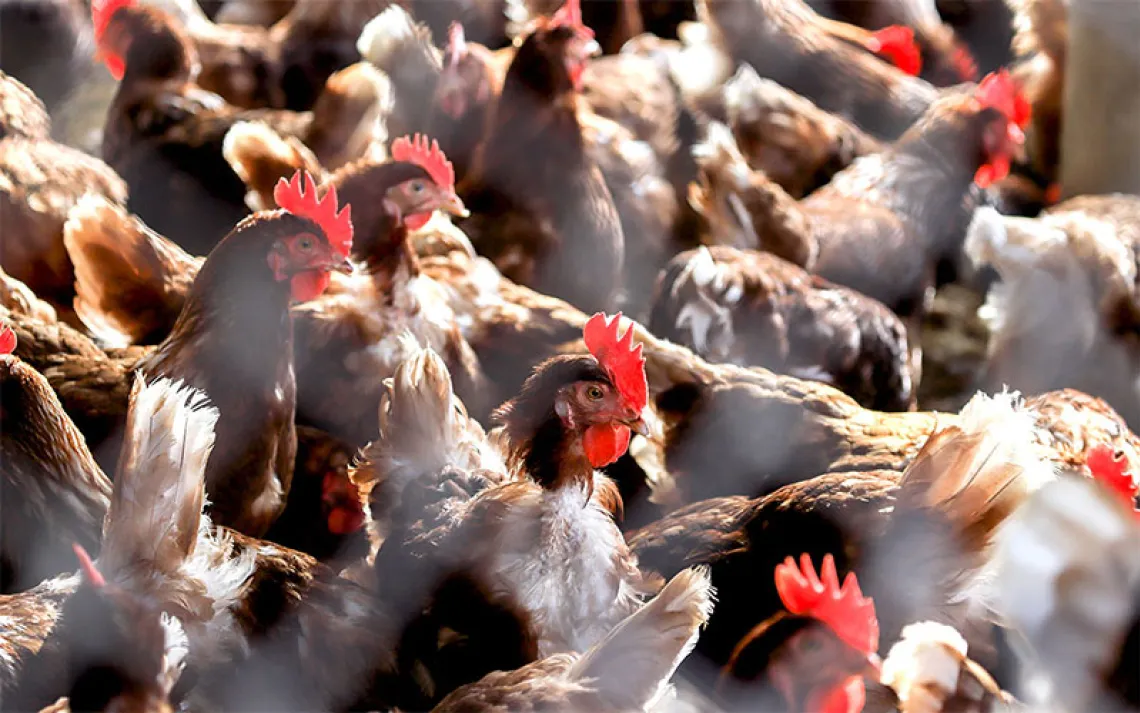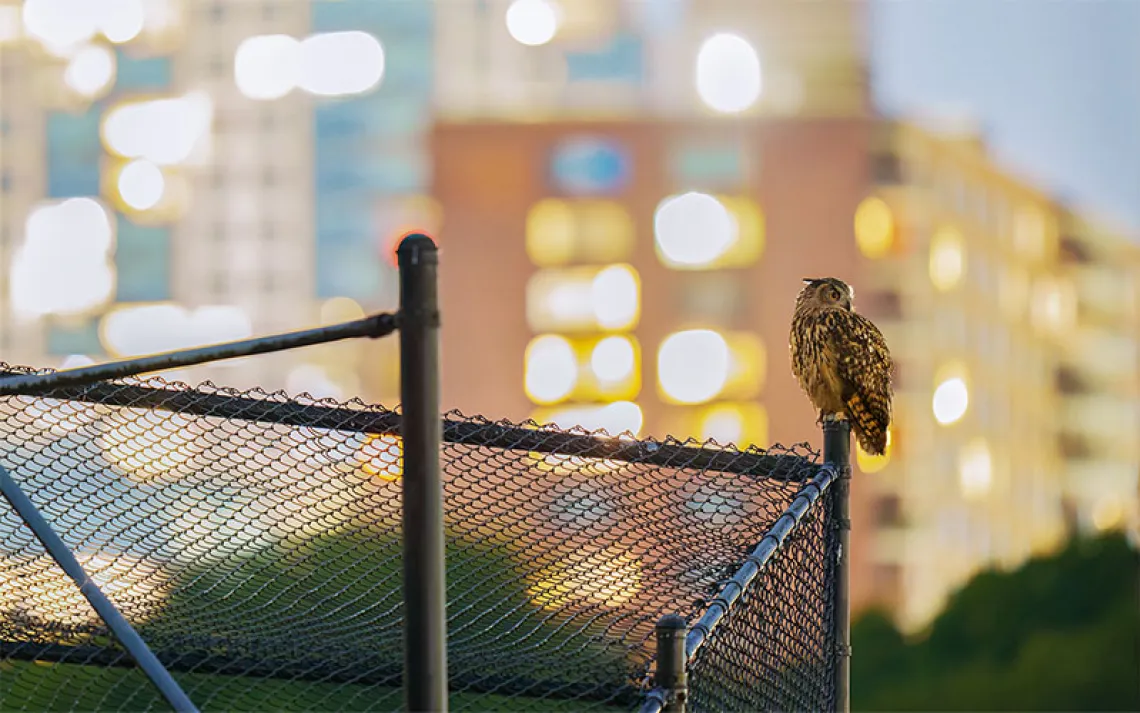Pondering Cranes With EarthWatch
A journey into the Aransas National Wildlife Refuge to track the whooping crane

Photo courtesy of Barb Rumer
The sky in the Aransas National Wildlife Refuge is as wide as Texas, but my task is to focus on a small, white spot on the horizon. I am not close to the current object of my attention, a whooping crane, but I am studying it intently—eyeballs locked onto every shift and flutter of the crane through the high-powered binoculars I've balanced atop a monopod. The closer you pay attention to something, I've learned, the more interesting that something becomes.
Lindsay, cheerful research assistant and co-leader of the EarthWatch expedition for which I've volunteered, admits that her favorite bird is actually the loggerhead shrike. “It's the only predatory songbird!” she tells us excitedly when she spots one. She also likes snowy egrets, with their goofy yellow feet, and is thrilled to see the awesome crested caracara. Only once this week has she been unable to identify a winged thing, and that was an insect.
Our mission, though, involves the whooping crane. We observe them from a small boat, which rocks and sways beneath our marsh-muddy boots. Every 15 seconds of each 20-minute observation period, I am to discern whether my crane is foraging, on alert, interacting, comforting, or locomoting. Every 15 seconds, when the timer sings out “mark!” I am to report my crane's behavior. “Loco!” shouts Mareka, as her crane walks toward mine, threatening to turn two white spots on the horizon into one, a locomotion sure to muck up the data. “Foraging” I call out, wishing my crane would do something different.
Whoopers (some folks pronounce the w and others don't) are the tallest of all birds in North America. Their five feet of height is all leg and neck and feathers, weighing in at only 16 pounds. Their plumage is white but for their dramatic black wingtips, visible only when they spread those magnificent arms to a 7-1/2-foot wingspan to fly. Hunted almost to extinction for their feathers, a single flock of 14 cranes remained in 1941. That flock, still the only natural flock in the world, has grown to 340. They breed in Canada and each year fly 2,500 miles to overwinter at Aransas.
Conservationists’ efforts to breed cranes to form other flocks have been thwarted. The new crane-lets wouldn’t migrate until they were taught to follow an ultralight airplane. Then they wouldn’t mate. The few that mated successfully have bad parenting skills. The single crane that managed to fledge a colt was shot last year by a hunter.
The crane I am observing is thus a very special bird. The data we gather in this one-week expedition will help researchers better understand its habits and its habitat. Tomorrow we will switch from observing cranes to surveying the marsh, so the next eight minutes might be my last chance to glean insight into this regal avian.
I am squinting through the binoculars for a better look when my subject suddenly stiffens his neck, points his beak into the air, and looks straight toward me. “Alert!” I call out.
*
In the small cabin I share with other EarthWatch volunteers, we each have about four square inches of personal space in which to shuffle our belongings, wiggle into our field gear, and pack our lunches for the day. We didn’t sign up for a luxury vacation. We signed up for a learning adventure—the chance to be citizen scientists for a week, to explore the wetlands and birds of the Texas Gulf as tourists never will.

Sign up to receive Sierra News & Views
Get articles like this one sent directly to your inbox weekly.
With this action you affirm you want to receive Sierra Club communications and may vote on policy designated by the Sierra Club Board.
Jeffrey Wozniak, aquatic ecosystems ecologist and leader of this expedition, is happy to deliver. He is patient with our endless questions, dogged in his quest for data, and unfazed when we drop our binoculars in the water. He mentions that from today until the end of the trip, we can expect to be wet and muddy. That turns out to be an understatement.
Mature whooping cranes, which hang out in breeding pairs, like their space. Get this: Each crane pair claims 300 to 500 acres of wetland marsh for its exclusive territory. If a crane has the audacity to approach the outer limit of a territory not its own, it will be chased off. The resident cranes are not just being huffy; it’s a matter of survival. It takes a lot of crabs and wolf berries to fuel a flight back to Canada, and they are not inclined to share.
If you do the math—340 cranes, 400 acres of wetlands per two birds—you will quickly realize that this singular flock needs a lot of wetland. Researchers out to assess crane territory must therefore cover a lot of marsh. When you jump off the boat onto the spongy ground, at first you think it will be easy. Once you have lost your shoe in the aggressive muck, fought the powerful suction of the swamp, fallen into a pond while counting crabs, and batted away mosquitoes and failed, despite all efforts, to find a single wolf berry, you form a grudging admiration for the cranes.
We volunteers all want our turn with the gadgets—the one that measures salinity and conductivity, the range-finder, the little fan that calculates wind speed. I like best the orange notebooks in which we record data. We pace off 15 meters, place our quadrants on the ground, call out our findings, and try to act like real scientists. The jaunty hat I thought would complete my field research outfit is tangled up in my mosquito mask. Sue calls for a consult: berry or fat leaf? Since we've not yet seen a wolf berry, we’re not sure what they look like.
Our small piece of the research pie may seem insignificant, but to effectively do ecosystem science, Jeff explains, collaboration is needed across multiple disciplines: hydrology, biology, meteorology, economics, geology. Everything overlaps—the rain, salt, bugs, birds, plants. Nothing is assumed, everything is measured, and all of it counts.
Photo courtesy of Kim Green
*
Back at the launch, the volunteers talk birds over lunch. I tell them about the Magellanic penguins in Patagonia, remembering the humanlike qualities of those social, impish waddlers, their crowded colony, their quizzical looks as we walked among them. The cranes, by contrast, are distant, sleek, cool. That we cannot interact with them, or get close enough for a bare-eyed look because of their status as an endangered species, adds to my impression that they are standoffish. They don't even migrate as a group. Fratricide is the norm when two chicks hatch.
If the cranes seem elitist, their devotees come in all flavors and stripes. Local pride in the whooping crane is evident from our conversations with the folks in Hopper's Fish Camp and Tavern. The tavern, decorated with dusty baseball caps, mounted game head, and a blaring flat-screen TV, is where we chow down every night and buy $2 beers. You will find fishermen and campers, birders, beer drinkers, and biologists at the tavern, and each has a favorite whooping crane story.
These birds inspire wonder and respect as rare and beautiful beings. Their needs are simple and specific: crabs, wolf berries, and a wide-open estuary they can call their own. Most territorial disputes seem to be settled with little more than a kerfuffle, and they happily share their yards with egrets and herons, laughing gulls, and common pelicans. I'm beginning to feel a little lift in the heart when I see, off in the distant patch of green, two white forms that I have come to know as a pair of whoopers.
*
As the expedition ends, the volunteers trade highlights. For Mareka, it was first hearing the honking of a pair of cranes whose territory was encroached upon, seeing them flatten their necks for take-off, spread their massive wings, fling their legs behind their bodies, and whoosh into the sky toward the intruders, who themselves flew off in retreat. It was a sight to see, and all the more impressive for the time and effort it took to get to that remote area and learn what to look for; the patience it took to simply sit, wait, and watch.
Me, I liked the learning. I liked walking in the muddy boots of a researcher, shooting the breeze with the local naturalist, milking the scientist for every nugget wrestled from the data. Everything overlaps, and all of it counts.
One day on the boat, I gazed across the bay to the marsh, happy to have surrendered my binoculars to another volunteer. From the corner of my eye I saw a flock of white ibis flying in formation, wings sparkling. I watched as they flew into the distance and disappeared. My sensibilities having slowed to a comfortable pace of lazy alert, I kept staring into the sky. Suddenly, a white flash of a hundred flapping wings appeared again as the birds made a turn and caught the light. Then they were gone. And then again the sparkle—a flash of glitter catching the sun.
 The Magazine of The Sierra Club
The Magazine of The Sierra Club



